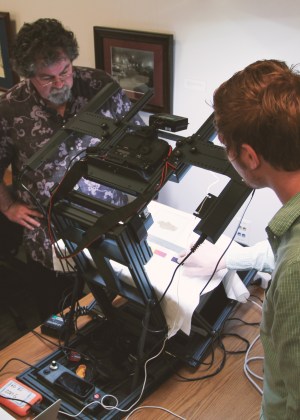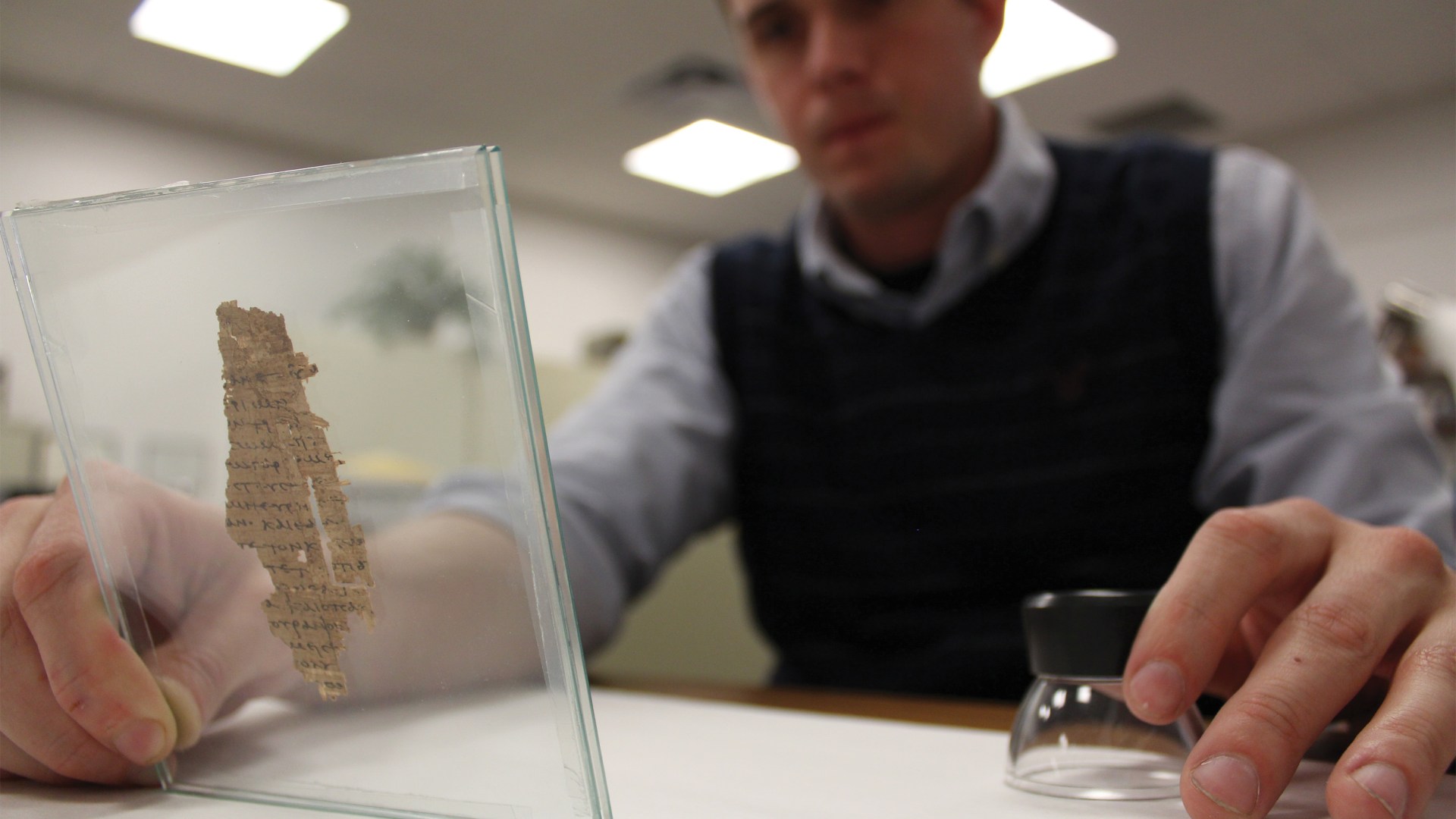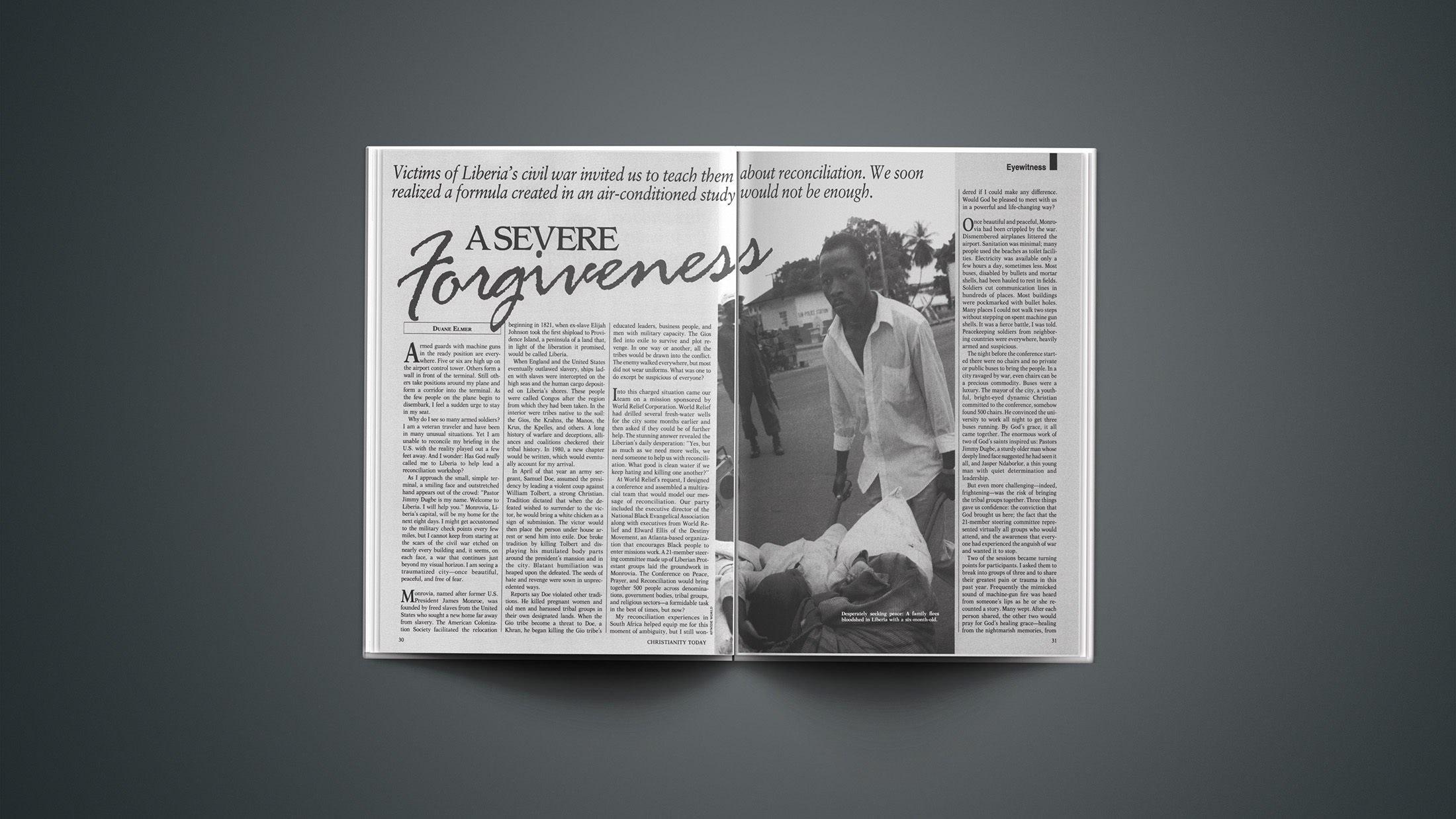When he finally figured it out, Rory Crowley burst into tears.
He was alone in a dark Dallas apartment with one lamp and a laptop on, hunched over a high-quality photo of a battered piece of papyrus.
There was Greek writing on it. Someone living maybe 150 years after the Crucifixion had written down the words of Jesus. Crowley and the other young men at Dallas Theological Seminary studying this papyrus with their professor, Daniel B. Wallace, had recognized some of the text immediately. It was the Gospel of Matthew—the Sermon on the Mount. And some seemed to come from a similar part of Luke, the Sermon on the Plain.
But a middle part, they couldn’t identify.
“You fast,” it said, “you will never find and unless you … the world you … the Father … the birds, how. …”
For hours and hours and weeks and months, they puzzled over it. Then Crowley suddenly saw it was a bit of the Gospel of Thomas, a noncanonical text of sayings attributed to Jesus. The words in front of him matched a passage that says to “fast from the world” or you will never find the kingdom of God and see the Father in heaven.
Whoever wrote this text wove together different sayings from different places, compiling Jesus’ teachings about worry. And Crowley—who was up at 2 a.m. because he couldn’t sleep and thought he might as well work—understood.
“I was crying,” he told CT. “I felt like I was in conversation with the mind of a believer. This is a faithful Christian, in my opinion, who knows there’s this really incredible Jesus guy.”
The scholarly report on the fragment that Crowley and others worked on in 2012 and 2013 was published this year, at the end of August, after more than a decade of rumors swirling through academia. Some once said this papyrus was from an early, early copy of Matthew. Others said it had been pried from a mummy mask. Neither turned out to be true, but according to the scholars who worked on the fragment, the truth is better: This fragment reveals something about how people in the late 100s or early 200s engaged with the teachings of Jesus.
“This gives us a glimpse,” said Michael W. Holmes, an emeritus biblical studies professor at Bethel University. He, Wallace, and Jeffrey Fish at Baylor University coauthored the report, acknowledging eight former Dallas students.
“Was it part of a larger sermon? Was it a private meditation? It’s so short that all one can do is speculate,” Holmes said. “But the canon was still taking shape at this time. Sayings were circulating in oral form, probably there were little collections in written form, and then you have written Gospels. And in the second century, these are all side by side and it’s very fluid.”
The report’s publication has caused a stir among specialists in early Christian texts. The papyrus, now known as P.Oxy. 5575, may be the oldest surviving written record of the Sermon on the Mount. It is thought to be the earliest, or one of the earliest, pieces of the Gospel of Thomas. And it is the only known text of its era that puts these sayings of Jesus in conversation with each other.
A month after the report was published, members of the North American Society for the Study of Christian Apocryphal Literature got on Zoom to discuss the fragment. They analyzed possible genre classifications, the dating, and its relationship to other early Christian texts.

Some also expressed reservations about the odd history of this piece of papyrus and how it came to be studied by a bunch of evangelical grad students and three professors who are all connected to the Museum of the Bible.
The history is odd.
The scrap was originally excavated from a garbage dump in an Egyptian city with a Greek name: Oxyrhynchus. In the winter of 1897, two Oxford scholars started digging there and found papyri preserved by the sand and dry weather. Lots and lots of papyri.
Within a few months, they had extracted almost 2,000 pounds of texts. Over the next decade, they moved more than 500,000 fragments back to Oxford and stored them in the Egypt Exploration Society (EES) collection’s library.
To date, an estimated 1 percent of the Oxyrhynchus papyri have been published. The fragments include receipts, court records, tax documents, and contracts. There are ancient bits of Plato, Euclid, and Homer, a forgotten Sophocles play that involves a satyr, and lots of early Christian writings, including prayers, hymns, homilies, and Scripture.
For nearly 127 years, scholars have been slowly making their way through this trove of archaeological treasure. According to EES, however, the wealth was too tempting for one man. Dirk Obbink, a leading papyrologist who oversaw part of the collection, allegedly stole more than 100 fragments and sold some to the people planning the Museum of the Bible, obscuring their true origin.
In 2012, these fragments were sent to evangelical scholars who could train grad students while doing original research. Wallace, also the founder of the Center for the Study of New Testament Manuscripts, got a piece about an inch and a half wide and three and a half inches long, protected between panes of plexiglass. It was called “Matt Frag.”
Neither Wallace nor the eight Dallas students he recruited could have imagined it was stolen. Nor did they think it had any association with the excavation of Oxyrhynchus. They did, however, suspect the text might have been extracted from a mummy mask.
“Dirk Obbink was disassembling these mummy cartonnage, which is like papier-mâché,” said Peter Gurry, a New Testament professor at Phoenix Seminary who was one of Wallace’s students at the time. “Basically, he’d take water and liquid detergent, a very gentle liquid detergent, and it comes apart in pieces of papyri. Lo and behold, some of them have text on them.”
The students, however, didn’t worry about where it had come from. They focused on learning the skills necessary to understand their piece of papyri. They went to Wallace’s house about once a week for an intensive independent study.
“Just deciphering the text is very challenging,” Wallace told CT. “You don’t have the left margin. You don’t have the right margin. You’re looking at a fragment that’s in the middle of something. You start with just a part of a word.”
As they deciphered the Greek together, they recognized lines that were pretty close to Matthew and Luke, verses about not being anxious for anything and considering the birds. And they realized there was another bit that didn’t seem like anything in the New Testament. The papyrus wasn’t an early Gospel of Matthew. But they didn’t know what it was.
The next task for the team was figuring out the date of the document. Wallace sent them looking for other ancient manuscripts to compare different styles of handwriting until they could place their fragment in a particular generation of Greek penmanship.
“You really don’t get confident until you’ve looked at not just dozens but hundreds of papyri,” said Zach Cole, a New Testament professor at Reformed Theological Seminary who was also one of Wallace’s students at the time. “You look at how an alpha gets shaped and you really start to develop a comparative sense—but that is a conceivably endless task.”
After comparing, comparing, and comparing, all eight wrote arguments for a particular date. They each concluded that the script was closest to manuscripts that had been dated to the late second or early third century.
Then in June 2013, Crowley made the connection between the unfamiliar lines of text and the Gospel of Thomas. It happened after he’d spent hundreds of hours looking at the fragment side by side with other ancient fragments. And then all at once, there it was: A passage from the first Oxyrhynchus text, P.Oxy. 1, published back in 1898, matched.
“Lord,” Crowley said, “you’ve allowed us to find this.”
It wasn’t until a few years later that he and the other students learned the papyrus they had studied rightfully belonged to the EES and never should have ended up in Dallas. It had never been part of a mummy mask but instead sat in a box in Oxford for more than 100 years before being swiped.
The Museum of the Bible returned the stolen property, and the heads of the Oxyrhynchus collection decided, graciously, to let the evangelical scholars go forward with their research.
To those scholars, it seems in retrospect like a miracle, or at least one of the mysterious ways God moves.
Now that the fragment is published, they realize the puzzle they were working on was just a piece of a larger puzzle. Their research will provoke debate and more research, which is how it goes with scholarship.
But they also realize that, for a moment, their work connected them across millennia to another person who was deeply moved by Jesus.
“This manuscript is a reminder,” Gurry said, “that Jesus’ teaching was seen as kind of amazing. And Jesus’ teaching is kind of amazing. People have always worried, and Jesus has given us the most profound way to think about those worries.”
Daniel Silliman is CT news editor.













